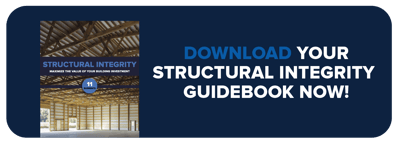Posts | Building Tips | Structural Integrity
5 Reasons Why Pole Barn Truss Spacing Is Important
Angie joined FBi Buildings in 2012 and is now the Director of Marketing. She's an avid reader and enjoys outdoor leisure and cheering on her two daughters at their sporting events.
 Whether you refer to them as pole barns or post frame buildings, one thing is certain... the post frame building design has evolved significantly over the years. From round poles to laminated columns, from nails to stainless steel screws, from Silicone Polyester to Kynar, the post frame building continues to innovate.
Whether you refer to them as pole barns or post frame buildings, one thing is certain... the post frame building design has evolved significantly over the years. From round poles to laminated columns, from nails to stainless steel screws, from Silicone Polyester to Kynar, the post frame building continues to innovate.
The truss is just one component in the overall building system. Believe it or not, you can have the strongest truss system and your building may still fail. Just wait… we’ll get to that in a minute.
But remember, it’s important that the load path is followed all the way to the foundation of the building as it resists multiple loads, oftentimes occurring simultaneously. Trusses must handle all the loads applied to the roof via the roof steel and purlins and transfer those loads effectively to the columns.
For starters, it’s helpful to know what exactly is a pole barn truss and how it affects the structural integrity of your building.
What is a Pole Barn Truss?
A truss is the rigid framework of wooden members designed to support a roof. Trusses are comprised of a top chord, a bottom chord, and webs connected at the joints with plates. The actual truss profile, spacing, span, heel height, pitch, overhang, and web configuration are dependent on the specific design conditions and will vary by application.
What exactly does all that mean? Your truss will be designed specifically for your building based on the building’s use.
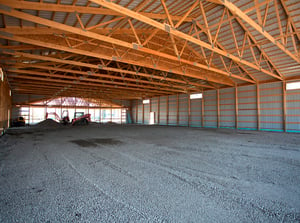 It’s not uncommon for post frame builders to have varying truss specifications. Make sure your builder understands the requirements of the local building codes, understands the tentacles of adjusting truss features, and understands your end-goal as they assist in providing the right truss for your next post-frame project.
It’s not uncommon for post frame builders to have varying truss specifications. Make sure your builder understands the requirements of the local building codes, understands the tentacles of adjusting truss features, and understands your end-goal as they assist in providing the right truss for your next post-frame project.
In addition to supporting the roof and connecting one side of the building to the other, trusses are a key component of the load path. They must handle all of the loads applied to the roof via the roof steel and purlins and transfer those loads effectively to the columns.
In this article, we’ll provide the answers to your burning questions by discussing how:
- 8’ O.C. trusses differ from 4’ O.C. trusses
- Trusses affect the structural integrity of a pole barn
- How the truss to column connection affects the structural integrity
- Pole barn trusses have evolved over the years
- Engineers play a vital role when designing trusses
By the end, you’ll have greater confidence to make a well-informed buying decision.
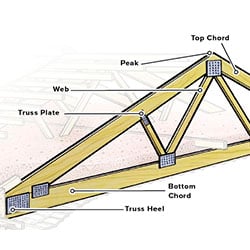
1) What’s the Difference Between 8’ O.C. Trusses and 4’ O.C. Trusses?
It’s important to have the mindset that “bigger isn’t always better.” What exactly do I mean by that when comparing 8’ and 4’ trusses?
A truss constructed of larger chords using a low-grade lumber may be weaker than a truss constructed of smaller chords using a higher-grade lumber. Trusses made with extra-large chords may look impressive, but they may not be able to carry any additional load.
FBi typically uses an 8’o.c. truss while some of our competitors use a 4’o.c. truss. There’s a common misconception that the 4’o.c. truss is stronger because they’re spaced closer together. In reality, the 4’o.c. truss only needs to carry half of the load that the 8’o.c. truss needs to carry.
The 4’o.c. truss will only carry 2’ of the load from one direction and 2’ of load from the other direction. Whereas your 8’o.c. truss will carry 4’ of the load from one direction and 4’ of load from the other direction.
Post frame buildings that incorporate 4’o.c. truss systems typically keep the columns spacing set at 8’ on center. To support the intermediate trusses that do not align with the 8’o.c. columns a continuous header is typically installed along the sidewall. This header will likely result in reduced building clearance.
This system also introduces additional connections into the load path. The intermediate truss-to-stub connection, stub-to-header connection, and then header-to-column connection are all critical connections.
To contrast the 4’o.c. truss system, an 8’o.c. truss system eliminates the continuous header system (keeping building clearance for you!) and reduces the number of connections along the load path.
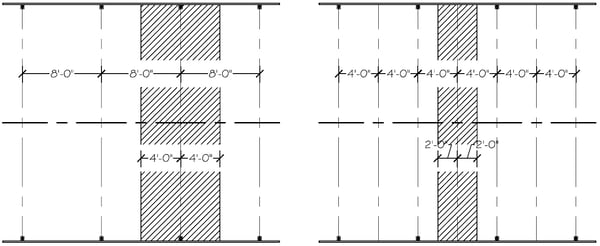
Another way to compare your truss specifications with competitors is the load composition. On the truss drawing, look for top chord live load (TCLL), top chord dead load (TCDL), & bottom chord dead load (BCDL).
These values alone may not tell a complete story about the loading on your truss, but they’ll give you a great start.
- TCLL is typically controlled by snow. How much weight can this handle without failing?
- TCDL consists of the framing members and cladding elements (think purlins, steel, or shingles). Does this value accurately reflect what your building needs?
- BCDL consists of the framing member and cladding elements in the ceiling area of the building (think drywall or lights). This number will vary depending on how the buyer is going to finish the interior of their building.
2) How Does the Truss-to-Column Connection Affect Structural Integrity?
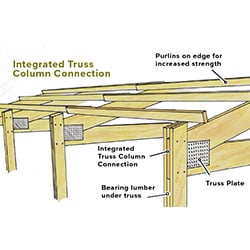 Properly designed, truss-to-column connections strengthen and stabilize the truss. It is vital that this aspect of the load path through which all roof loads are transferred to the ground be properly engineered and not left to the discretion of the post frame builder.
Properly designed, truss-to-column connections strengthen and stabilize the truss. It is vital that this aspect of the load path through which all roof loads are transferred to the ground be properly engineered and not left to the discretion of the post frame builder.
Follow the load path to see how the load is transferred from the roof to the columns to the ground. High-quality construction and design optimizes the use of bearing lumber and minimizes points where the load transfer is reliant upon the strength of fasteners.
With an integrated, or “saddled,” connection, the truss is interlocked with (not just attached to) the column. Secured from both sides with nails, structural screws or bolts, this truss-to-column design significantly increases the strength of the connection.
The results of using a saddled connection are:
- A firm, interlocking wall system
- More efficient load transfer from the roof to the ground to efficiently transfer snow and wind loads
- Increases usable space at the building’s interior–does not require knee bracing (a diagonal brace extending from the column to the bottom of the truss)
We can’t explain the pros of a proper truss-to-column connection without talking to you about some of the cons. Before you choose a post frame builder, it’s critical that you ask them questions about the construction of their trusses. If they follow any of the below practices then it might be in your best interest to reach out to a different builder.
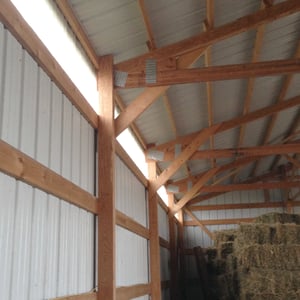
1) Weak Truss-to-Column Connection
With overlapping connections, the truss simply sits on top of or to the side of the column and relies on field installed fasteners to transfer the loads.
2) 4-foot O.C. Trusses Nailed into the Header
Typically, the trusses of a 4' O.C. system:
- Are designed to carry half the load of the larger 8' on center trusses
- Have many more critical connections
- Result in reduced clearance
- Sit on top of a 1 ½" header board that is attached to the columns by fasteners not strong enough to carry design loads
3) Knee Bracing
Knee bracing is an outdated way to compensate for a weak truss connection. It also reduces the amount of usable space along sidewalls and can cause structural damage to the building if hit.
Reference picture to the right for an example of knee bracing.
3) How Do Pole Barn Trusses Affect Structural Integrity?
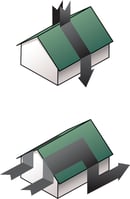
Structural integrity refers to a structure’s ability to withstand anticipated structural loads without breaking. Any building, regardless of size or location, must be designed to resist both vertical and lateral loads safely.
Having well-designed trusses is essential because if one fails, the others will follow pursuit. This domino effect results in building collapse. We wouldn’t want that to happen!
The truss profile, span, heel height, overhang, and web configuration depends on the specific design conditions and will vary by application.
What exactly does all of that mean? Your truss will be designed specifically for your building based on the building’s use.
4) How Have Pole Barn Trusses Evolved?
Over the years, the span size of trusses has evolved. In the 1980s, post frame construction companies commonly used 60’ (single ply) trusses. Typically, larger trusses (72’ and 80’) were two-ply. The more ply (or layered material), the stronger the truss.
At the time, pole barn builders were unable to hang or lift the trusses without any bending/bowing. The higher up in the air, the more stress placed on the lumber. Therefore, it was easier to produce and swing one-ply (60’) trusses.
There are two ways to grade lumber: visually and mechanically. First, visual grading is done manually. A trained inspector examines the boards and assigns a grade based on set criteria. Then, the board is stamped with its grade.
The grade is important in two ways: aesthetics and design strength. Engineers use reference books such as the National Design Specification for Wood Construction to determine the design values for each species. The grade shows how much the wood fibers can take in terms of bending, compressive, tensile, and shear stresses.
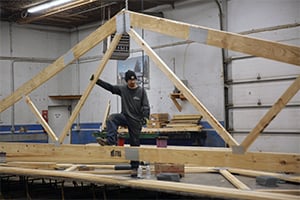 At FBi Buildings, our in-house truss plant uses Machine Stress-Rated (MSR) lumber. Each piece of MSR lumber is tested for stiffness and strength in an electromechanical machine. To further refine the assessment, it’s visually inspected to determine a grade. As a result, we know the lumber’s strength before we hang it in your building.
At FBi Buildings, our in-house truss plant uses Machine Stress-Rated (MSR) lumber. Each piece of MSR lumber is tested for stiffness and strength in an electromechanical machine. To further refine the assessment, it’s visually inspected to determine a grade. As a result, we know the lumber’s strength before we hang it in your building.
One thing to keep in mind is that there isn’t necessarily a “standard” when it comes to what species or grade of lumber needs to be used on your trusses. However, understanding the “scale” of grading system may help you make a more informed decision.
The chart below compares design values for a 2x8 Southern Yellow Pine member across four different grades: No. 2, No. 1, Select Structural and MSR2400. You can see that mechanically graded, MSR lumber, is the strongest option.
2x8 Southern Yellow Pine Grade Comparisons
| Reference Design Values | No. 2 | No. 1 | Select Structural | MSR2400 |
|
Bending Design Value, PSI |
925 |
1250 |
1950 |
2400 |
|
Tension Design Value Parallel to Grain, PSI |
550 |
800 |
1350 |
1925 |
|
Shear Design Value Parallel to Grain, PSI |
175 |
175 |
175 |
175 |
|
Compression Design Value Perpendicular to Grain, PSI |
565 |
565 |
565 |
565 |
|
Compression Design Value Parallel to Grain, PSI |
1350 |
1500 |
1700 |
1975 |
|
Modulus of Elasticity, PSI |
1,400,000 |
1,600,000 |
1,800,000 |
2,000,000 |
|
Modulus of Elasticity for Beam & Column Stability, PSI |
510,000 |
580,000 |
660,000 |
1,020,000 |
|
Specific Gravity |
0.55 |
0.55 |
0.55 |
0.55 |
Regardless of the lumber grade, hanging large trusses is still a safety risk. Construction crews should proceed with caution when lifting trusses. We recommend experienced builders taking on this task.
5) Why Is It Helpful to Have an Engineer Design Trusses?
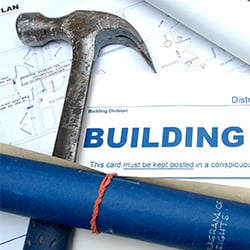 The knowledge of truss design and grading stems from engineering expertise.
The knowledge of truss design and grading stems from engineering expertise.
Civil engineering refers to the design, construction, and maintenance of buildings and infrastructure that make up our world. Typical duties of a civil engineer include:
- Analyze reports, maps, and other data to help plan projects
- Consider costs, regulations, environmental hazards, and other risk factors when planning a project
- Verify and submit permit applications to local, state, and federal agencies
- Provide estimates (i.e., materials, equipment, and labor) to determine project costs
- Test materials used in building projects
- Use software to plan and design structures that line up with industry and government standards
Some post frame companies hire external engineers. FBi recommends working with builders who have licensed engineers on staff. Why? Because outside firms don’t always have the customer’s best interest at heart.
Whereas, internal engineers work with you throughout the project. They think creatively and strategically to provide a better end product for the customer.
The FBi design and engineering department includes four individuals with engineering degrees. Their specialties include architectural, structural, and agricultural and biological engineering. Two are professional engineers, with one studying to take the test in the near future. They work closely with our salespeople to help determine design requirements while meeting customers’ needs and wants.
Are You Ready to Plan Your Next Post Frame Building?
We understand that it’s a lot of information to absorb (and understand)!
Trusses have come a long way since we joined the post frame industry in 1958. From truss span to lumber grading, it’s amazing to look back and see how far we’ve come. Of course, this is mostly in part to engineers and their contributions.
Are you ready for a post frame building? You can design your own building with our online 3D design tool. Save, print, or email your final plan to family and friends.
Are you interested in getting a pole barn price? Submit your design to us, and a member of our sales team will give you a call to begin the estimating process.
Do you have more questions that are not covered in this article? If you need help designing and planning, please contact FBi Buildings at 800.552.2981 or click here to email us. If you are ready to get a price, click here to request a quote and a member of our customer engagement team will help you determine the next steps of your project.


